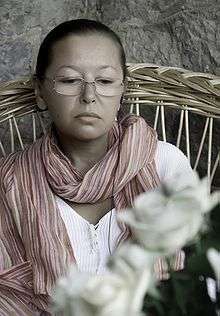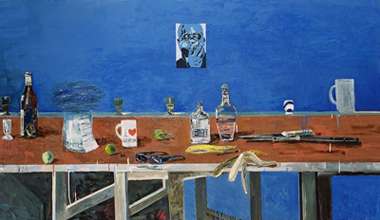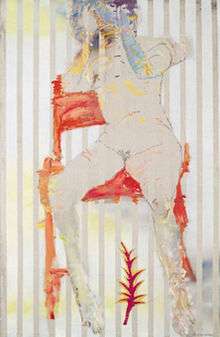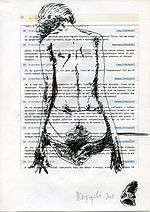Marina Skugareva
Marina Skugareva (Ukrainian: Марина Вадимівна Скугарєва, born 2 March 1962, in Kiev, Soviet Union) is a Ukrainian painter, one of the representatives of the "New Ukrainian Wave" in contemporary art.[1]
Marina Skugareva | |
|---|---|
 | |
| Born | 2 March 1962 |
| Nationality | Ukrainian |
| Known for | oil painting |
| Movement | contemporary art |
Biography
She is the daughter of journalist Olga Garitskaya and architect Vadim Skugarev, who was the head of a chair of decorative and applied arts (graphic arts department) at the Dagestan state teacher training institute (Makhachkala, Dagestan ASSR) since 1973.
In 1974 Marina entered Kiev Republican Art School. In 1981 she graduated from the Dzhemal Dagestan art school. From 1982–1988 she studied at the Lviv State Institute of Decorative and Applied Arts (Department of the Art Textiles).
In 1988 she married the painter Oleg Tistol and left for Moscow with him and painters Konstantin Reunov and Yana Bystrova. There they lived and worked in the squat "Furmanny Lane", and later in 'Trehprudny Lane", where the famous "Gallery at Trehprudny Lane" was situated, founded by Konstantin Reunov and Avdey Ter-Oganyan.
In May 1992 Marina Skugareva and Oleg Tistol received grants from the fund Christoph Merian Stiftung within the bounds of the program of a cultural exchange and left for Basel where they lived until 1993. In Switzerland they participated in several exhibitions with Gia Japaridze and André Clément. The Swiss artists Suzette Beck, Ronald Wüthrich, and Ilse Ermen became good friends of Marina and later even the heroes of her paintings.
Since 1993 Marina Skugareva has lived and worked in Kiev.
Work
Since the late 1980s, Marina Skugareva has participated regularly in exhibitions of modern art in Kiev, Moscow, Warsaw, Basel, Berlin, Odense. Her works are the part of a "new wave" - a movement which programmatically attributes its art to a postmodernism, updating the traditional Ukrainian art by its esthetics.

One of the main themes of Marina Skugareva's art is a naked human figure in space. For the artist this theme emerges from traditions of an expressionism, but Marina's expressions are not only the visible emotions, but also a manner of vision, a search of "another point of view", a way of preservation of "the real present life" in space of the art devastated by infinite citations and reproduction.

Her early works ("Nocturnal Kiev" (1988), "Der Vogel" (1990), "Poison Ivy" (1992)) are close to transavantgarde painting. In the late ones the expressivity departs, opening up the flood-gates of an accuracy of the statement and a rigid observation. There is a characteristic technique which appears already in Skugareva's first picturesque works—the embroidered fragment—a bird, a flower, a human face. By contributing this feminist tint to her paintings,[2] by uniting embroidery and painting techniques, Marina has united the femininity and the masculinity, the female needlework and figurative concept.
Since the middle of the 1990s Marina Skugareva has been working on the project of still lifes—"Tables". The painter transforms the oblong canvases ("Ronald", "Radio-gramophone", "Evening news"), cut across by the long near-empty tables, with the portraits of characters fixed on a conditional wall above, into the collision of several realities: the interior with the painting is continued in itself and the subjects represented in a picture are tested on reliability, so that glasses and chairs are made to seem more real than portraits.

"Fragments" is the name of another cycle of painting (2001–2003) which represents a life flared-out in episodes. The underlined fragmentariness and simplicity combine with bright intensity of colour to give a special semantic significance and free figurative breath to these works. Here the artist accents the value of "a private story".
The strange space, where reality is shown from different points of seeing occupied by the artist, characterizes her projects "Landscapes" and "Roads" (2004–2009). Compositions are constructed with a principle of "a sight from car window" or sometimes from a conditional top point of vision. As a consequence of the choice of distance which appears between nature and the person who observes it, nature looses its ingenuous breath being limited by the format of painting. In these paintings there are no human figures; the world is deserted, pointedly passionless, and at the same time sated and multiple-valued.
In 2007 Marina Skugareva presented the project of drawings "Good Housekeepers". It develops the subject of a naked figure in space, detecting new accents. In the majority of drawings Marina uses texts from women's Internet-chats which, being imposed on the naked figures, turn into tattoos.[3] The author's speculative strategy becomes comprehensible through the construction of drawings. The combination of the image and the text is used for "blackouting" the substance and the discrepancy. Texts represent the infinite women's conversations and images fix the forms of a human movement and frozen emotions. For the artiste the subject is just a springboard, she is not poeticizing the daily routine, but is rather gaining a victory over it with the help of art.[4]
Awards
- 1995. Ukraine. The winner of "Great Ukrainian Women Artist".
Collections
- The art museum of Zaporozhye, Ukraine
- Moscow House of Photography, Russia
- SK Johnson Kiev Corp., Ukraine
- Municipal gallery of Odense, Denmark
- Fund Christoph Merian Stiftung, Basel, Switzerland
Bibliography
- Sklyarenko G. Small Big World of Marina Skugareva // FINE ART. — 2009. — № 1
- Sklyarenko G. New Ukrainian Wave. (Нова українська хвиля ) // Українська нова хвиля.-2009
- О. Martynyuk. Nightingale and rose. (Соловей і троянда) // ART - UKRAINE.- 2009.- №3
- XX artists of Ukraine 2000 (End of the Century). - 2001
References
- "Marina Skugareva". Strange Time. Retrieved 2020-05-28.
- Stukalova K. Marina Skugareva // XX artists of Ukraine 2000 (End of the Century). — 2001.
- Tekila A. The dance of the good housekeepers // Symbol. — 2008. — № 1.
- Sklyarenko G. Small Big World of Marina Skugareva // FINE ART. — 2009. — № 1.
External links
| Wikimedia Commons has media related to Marina Skugareva. |